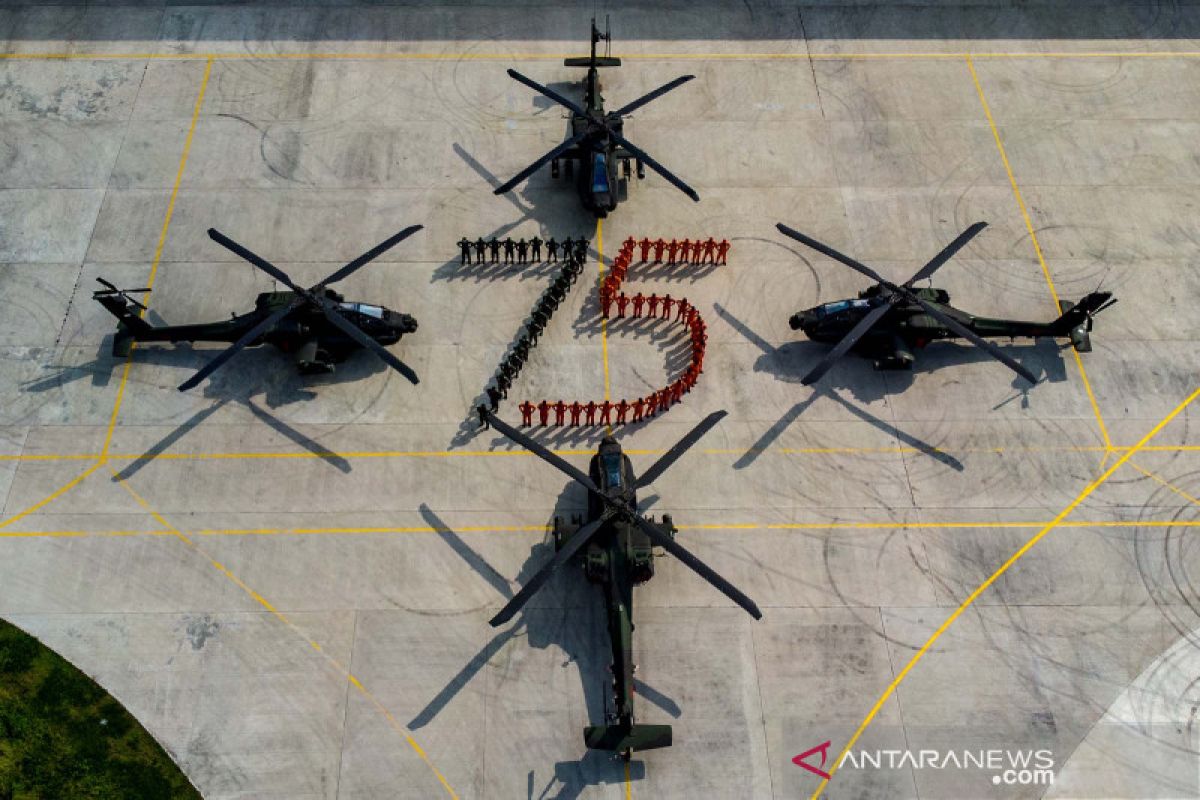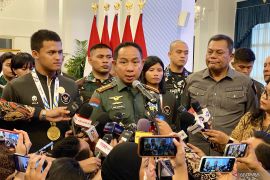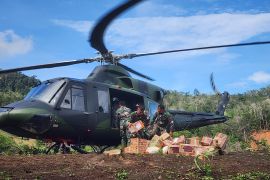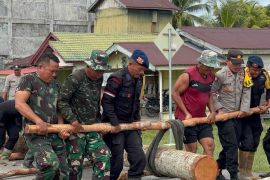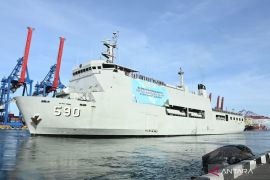**Rahmad Nasution is an ANTARA journalist
The Indonesian Defense Forces (TNI) commemorated its 75th anniversary on Oct 5 amid the government’s efforts to win a battle against the ongoing novel coronavirus disease that has gravely impacted public health and the economy.
Apart from this worrisome scenario, as the TNI commander-in-chief, President Joko Widodo (Jokowi) reiterated his support for TNI's transformation in accordance with the dynamics of the strategic environment, threats, and developments in military technology.
The president also unveiled that over the last five years, the TNI had brought about organizational transformation by forming new organizational units,
three Joint Regional Defense Commands, three Air Force's Drone Squadrons, and a TNI Cyber Unit.
President Jokowi affirmed that the formation of those new TNI units reflected the government's commitment to persistently supporting the transformation of the organization focused on intensifying its roles.
The transformation and development achieved by TNI deserve applause, but the matter of defense modernization is still viewed as an ongoing major challenge to enable the country to maintain its defense capability.
In the context of last year's presidential debate, it is worth noting that both Jokowi and his rival, Prabowo Subianto, currently the defense minister in his administration, had exchanged views and ideas on the state of Indonesia's defense capability.
One notable point highlighted was the issue pertaining to inadequate defense spending and the belief of a benign security environment for the subsequent two decades.
Candidate number 1 Jokowi, currently the president, stated that defense modernization had been going well, and the benign security environment had allowed the government to prioritize social and economic development.
Meanwhile, during that time, Subianto opined that the current defense spending was yet too low and that believing in predictions of a benign security environment was not a prudent decision.
This raises interesting questions in terms of the importance of developing Indonesia's defense capability. Can Indonesia afford to underinvest in defense in the perceived absence of the threat of external aggression? Can development of a robust defense capability; a defense capability strong in both external and internal defense be withheld until a later time?
Developing a robust defense capability is a long-term endeavor, necessitating years, if not decades, of unwavering commitment, and thus, is highly linked to the strategic outlook and threat assessment of a nation.
One simple method to gauge a country's strategic outlook and threat assessment is by looking at its defense white paper. In Indonesia's case, the 2015 defense white paper offers a glimpse into its strategic outlook and threat assessment.
A remarkable point worth noting about the defense white paper is that it highlights the unlikelihood of the threat of conventional war posed to Indonesia in the present and future. Instead, the paper stressed on internal threats, such as terrorism, radicalism, separatism, and natural disasters, as the main threats faced by Indonesia.
From that perspective, we can observe that the priority given to external defense in Indonesia is low. Statements in the defense white paper, published by the Ministry of Defense, suggest that top government and military officials do not perceive war as a likely threat to Indonesia.
This, of course, is an alarming prospect, especially if Indonesia aspires to develop robust defense capabilities that is highly linked to the strategic outlook and threat assessment of a nation.
In Indonesia's case, when the threat assessment itself denies the possibility of conventional war, it is hard to see how the country can plan to develop a robust defense capability.
Instead, by pointing out that the chief threats faced by Indonesia are internal in nature, its defense development could potentially be ensnared in prioritizing developments for internal defense capabilities while slowing development for external defense.
Indonesia's current defense modernization is centered on the Minimum Essential Force (MEF) Program. Launched in 2010, MEF aims to upgrade Indonesia's capabilities in waging modern military operations by 2024. Key elements of the MEF comprise the development of a “green-water” navy, major upgrades of air combat capability, a more mobile and agile land force, and the development of a viable domestic defense industrial base. (Schreer, 2013: 10).
However, nine years on, key goals of the MEF program are still far from realized. Despite improvements, the scale of these achievements casts a doubt over the completion of MEF by 2024.
Doubts loom large over whether the ambitious goals of creating a “green water navy,” with at least 12 submarines in operation, would be achieved by 2024, with the current trend of submarine procurement.
Moreover, the goal of major upgrades to the Air Force's combat capabilities had yet to be optimally achieved. Procurements of new fighter jets are few in numbers and critical support platforms, such as air tankers and AEW aircraft, have not been bought. Although the army has borne witness to greater mechanization, with the introduction of new tanks and armored vehicle, majority of its forces are still largely immobile.
One positive aspect is the growth of domestic defense industries owing to technological transfer schemes in defense procurement programs. Unfortunately, the defense industry is still increasingly dependent on imported parts, especially in the production of high-end weapon systems.
Inadequate defense budget has been one of the main obstacles in the path of Indonesia fulfilling its aspirations to develop robust defense capabilities. Despite a notable rise in the amount of defense spending in the past decade, as a share of the GDP, it has consistently stayed below one percent.
Although during last year's fourth round of the presidential debate, Jokowi had stated that the Ministry of Defense had the second-highest operating budget among other ministries, the consistent low GDP share of the defense budget indicates that defense is not a priority among Indonesian policy makers. In its place, priority has been accorded to infrastructure, education, and health.
Although low defense spending is inadequate to sustain military capabilities geared for external defense against conventional threats, it is capable of fulfilling the needs of internal security.
Furthermore, keeping a low defense spending coupled with investments in social and economic developments had been found to be effective in helping tackle internal security threats, such as separatism and armed rebellion (Collier, The Economics of Peace and Security Journal, 1, 2006: 13).
This is, of course, in line with the defense white paper threat assessment, which states internal security threats are the main threats faced by Indonesia. However, is it wise for Indonesia to continually underinvest in defense and focus on internal security matters?
Looking at Indonesia's profile as a large country, with a strategic geographical position and a positive economic outlook, continued underinvestment in defense will gravely hamper its ability to influence and shape regional developments.
Grand aspirations, such as the global maritime fulcrum (GMF), will remain out of reach as long as defense spending is inadequate since developing maritime defense capability is one of the key pillars of the GMF. It remains to be seen how Indonesia can assert itself as a significant maritime power when funds to develop maritime defense capability remains out of reach.
Apart from curtailing Indonesia's regional influence and aspirations, underinvestment in defense and a focus on internal security leaves Indonesia vulnerable to external threats. While the regional security outlook for the future might show the low probability of war and invasions, the fact also remains that the Asia-Pacific region has witnessed a spike in tensions arising from territorial disputes, such as in the South China Sea (SCS).
The recurrent use of military forces by the disputing states to secure their claims in the South China Sea poses increased risk of armed conflict. With close proximity of the SCS to Indonesia's Natuna Islands, the threat of conflict spillover is a real possibility.
While Indonesia is not part of the dispute, we also cannot disregard the fact that China's 9 dashed line claims in the SCS overlap with Indonesia's exclusive economic zone (EEZ) in the Natuna Sea.
Combined with China's significant power projection capability in the region, thanks to its artificial island bases, the threat of China's military cannot be ignored. Indonesia's response by strengthening military presence in the Natuna Islands is a welcome prospect.
Improving military facilities on the islands will facilitate better patrolling and surveillance of the surrounding seas. However, this only highlights the need for an overall upgrade on defense capability. Indonesia must develop robust defense capabilities to safeguard its territories and deter any potential threats.
In the end, we still believe that social and economic development is the most important aspect for a developing country, such as Indonesia. However, we must not ignore the fact that defense capability is still important.
Continued underinvestment in defense, excessive belief of a benign security environment, and focus on internal security matters will negatively impact Indonesia's ability to respond to external threats and limit its ability to influence the region. Although priority is currently given to social and economic development, we can also start mulling over how we envision Indonesia’s military capability in future.
As the traditional instrument of state power, Indonesia's military capability will play a significant role in defining its influence in future. The extent of Indonesia’s influence in future and its ability to respond to future threats will be decided largely by how strong Indonesia’s defense capability is.
The views and opinions expressed on this page are those of the authors and do not necessarily reflect the official policy or position of ANTARA News Agency
Copyright © ANTARA 2020
